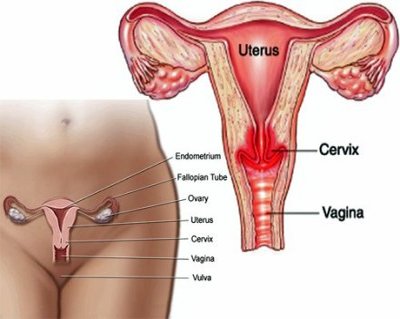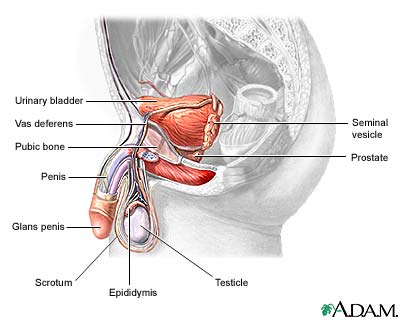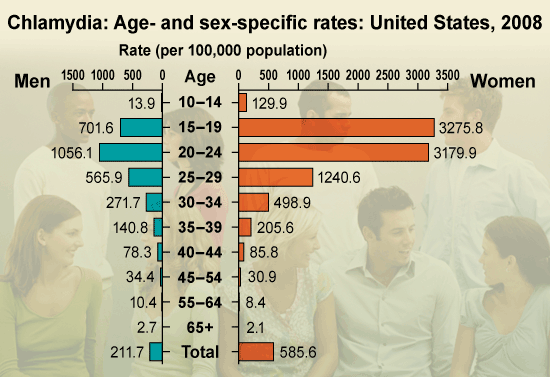Chlamydia Overview
Chlamydia, a common infection, is the most reported STD in the United States with over 1.3 million people infected in 2010. It's caused by the bacterium Chlamydia trachomatis which can cause serious irreparable damage to both the male and female reproductive systems, also known as the silent STD, it often has little or misinterpreted symptoms and in some cases will be completely asymptomatic.
Primarily transmitted through sexual contact condoms are very effective at preventing the transmission of the infection and should be used during all types of sexual contact including vaginal, anal, and oral. When left untreated complications of chlamydia can be quite serious and can damage sexual organs leading to infertility in women and in men. In women it can infect the cervix and urinary tract and can cause pelvic inflammatory disease (PID) when it reaches the fallopian tubes. In men it can infect the urinary tract and the epididymis causing swelling or inflammation of the testicles. Left untreated the infection can be quite harmful. Because of the lack of symptoms and long-term complications associated with chlamydia the Center for Disease Control suggests that sexually active people should be tested yearly.



Common Symptoms
If you have had unprotected intercourse in a non-monogamous relationship there is always a chance that you may have come in contact with chlamydia. Symptoms may be moderate to none, but normally develop one to three weeks after the initial infection.
In Women Symptoms May Include:
- Burning sensation when urinating.
- Vaginal discharge or A "mucus" coming out Of The vagina.
- White discharge
- Yellow discharge
- Low back pain.
- Unusual pains during intercourse.
- Bleeding between periods.
In Men Symptoms May Include:
- Burning sensation when urinating.
- Slow discharge or A "mucus" coming out Of the penis.
- Inflamed or swelling testicles.
- Sometimes uncomfortable itching around the tip of the penis.
A gallery of chlamydia and gonorrhea pictures can be found here.
U.S. Statistics by State Race Age and Gender

Reporting for chlamydia began in 1984 and rates have increased every year since then. Some of the increase corresponds with better access to testing, easier more accurate testing procedures, and advancements in the reporting system, but actual infection rates are on the rise.
Across the U.S. chlamydia has some of the highest rates of reported infection out of most sexually transmitted diseases. Women are the most at risk with more than double the amount of reported diagnoses than of men in 2008. As shown in the graph above. Teens and young adults ages 19 to 25 make up nearly half of all new infections every year with females being the most affected in that particular demographic as well.
2007 Rates per 100,000 by Age Group and Race/Ethnicity
| Age Groups | Asian/Pacific Islanders | Whites | American Indians and Alaska Natives | Hispanics | Blacks |
| 15-24 | 1124.3 | 10673.2 | 5413.8 | 3716.9 | 12979.2 |
| 25-34 | 481.5 | 572.6 | 2449.4 | 4734.3 | 3902.8 |
| 35-44 | 154.7 | 99.6 | 599.9 | 333.5 | 798.2 |
| 45-64 | 43.5 | 16.6 | 88.9 | 66.8 | 158.1 |
| Total Averages | 1804 | 11362 | 8552 | 8851.5 | 17838.3 |
Note: CO and HI did not report this year.
The table above represents reported 2007 data from the Center of Disease Control compiled in to race and age groups. The age group 15 to 24 has the highest rates of diagnosis except for in Hispanics where the 25 to 35 year old age group had the highest number of reported cases.
Blacks were highest by far over all with Asian and Pacific Islanders at an all-time low percentage wise, but the data is skewed because Hawaii didn't report this year. The table also shows the growing concern for the health care of Native Americans as this data accurately reflects current trends and gaps in the education and health care sector for AI/AN people.
While the younger demographic is the largest concern older generations are still at risk and should still be tested if they are sexually active.
Diagnosis and Treatment
Diagnosis techniques have gotten exceedingly better over the years for STDs including chlamydia. Physicians have two different options for testing including swabbing the urethra in men or the cervix in women to look for signs of the bacteria or a more comfortable option of using urine samples. When using urine samples it's important to make sure that the patients sample includes the very first part of the urination because that's the point of build up of the bacteria.
If diagnosed with a positive result it's important that all of the patients' recent past sexual partners be tested as well, and all parties should refrain from intercourse to minimize reinfection until at least one week after completing treatment.
Chlamydia can be treated and cured easily by your doctor with antibiotics with either one single dose of azithromycin or a twice daily regimen of doxycycline for one week.
Common Myths and Misconceptions
The Myth
If you have had chlamydia and had it treated you can never become infected with it again.
Fact
Chlamydia is a bacterial infection. So once you are infected and have been effectively treated it is just as possible to contract the infection again in the future. In fact, it is quite common for people who are infected to pass the infection back and forth during treatment, which is why it is imperative to refrain from sexual contact until the treatment is completed. (Make sure to talk to your doctor about when it is safe).
The Myth
You can never have children after getting an STD.
Fact
While certain infections can render a person infertile, if proper treatment is sought out within a reasonable time frame most people's reproductive systems will not be affected.
The Myth
You can contract it from a toilet seat or towels.
Fact
Neither of the two, or similar situations, are common ways to contract most diseases.
The Myth
People who have contracted the disease will always show obvious symptoms.
Fact
Chlamydia is often referred to as "the silent disease" for a reason. It often doesn't show obvious symptoms.
The Myth
Once you contract chlamydia you will have it for your lifetime.
Fact
If not treated, you will have the disease for your lifetime, but with simple treatment options available it can be cured quite easily if within a reasonable time frame.
The Myth
STD testing is part of a yearly exam by your physician.
Fact
In almost all cases testing is not performed during most yearly exams unless requested or if there is an assumption by the physician that testing should be performed.
The Myth
You can contract chlamydia by kissing.
Fact
Kissing is not a primary way to contract chlamydia. While it is possible to contract infections this way it's very unlikely in this case.